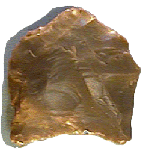

Point Type: PELICAN
Also See: Hell Gap, Lake Mohave,
Midland, Rio Grande, San Patrice
Location: Midwestern United States
Associated Dates:
10,000 - 6000 B.P. Transitional Paleo - Mid Archaic
Morphology: Auriculate
General Description: The Pelican point is a short, broad, usually auriculated point with basal grinding and thinning which sometimes takes the form of fluting. The shoulders taper into a long contracting stem. Some specimens are basally thinned or fluted. Grinding is usually present on the base and up the sides of the hafting area.
The Pelican was named by Sherwood M. Gagliano and Hiram F. Gregory Jr. for specimens they found in Louisiana.
About My Point Above: The small stubby Pelican point pictured at the top of this page, was found near Leesville in Vernon County, Lousiiana. It is made from a glossy olive green and brownish flint material. The pictured point should not be considered a classic example for the type but is typical of the totally exhaused and heavily reworked Pelican stubby sub-type. Overall, the point measures 30 mm in length, is 25 mm wide (at the top of the halting area) and is only 6 mm thick at the shoulders. The base has been thinned with the removal of three thinning flakes from one face (pictured) and a small single flute from the other side. The basal edges are then retouched with smaller thinning edge flakes. The basal auricles are 24 mm in width and the concavity of the base is 3 mm in depth. The base is ground and the entire hafting area edges are also ground. Catalog Number LA44-10-C
References: Justice, Overstreet, Turner & Hester
© Copyright 1997 - 2008 LITHICS-Net WWW.LITHICSNET.COM
Use Your Browser's BACK Button to Return to the LITHICS-Net Index.